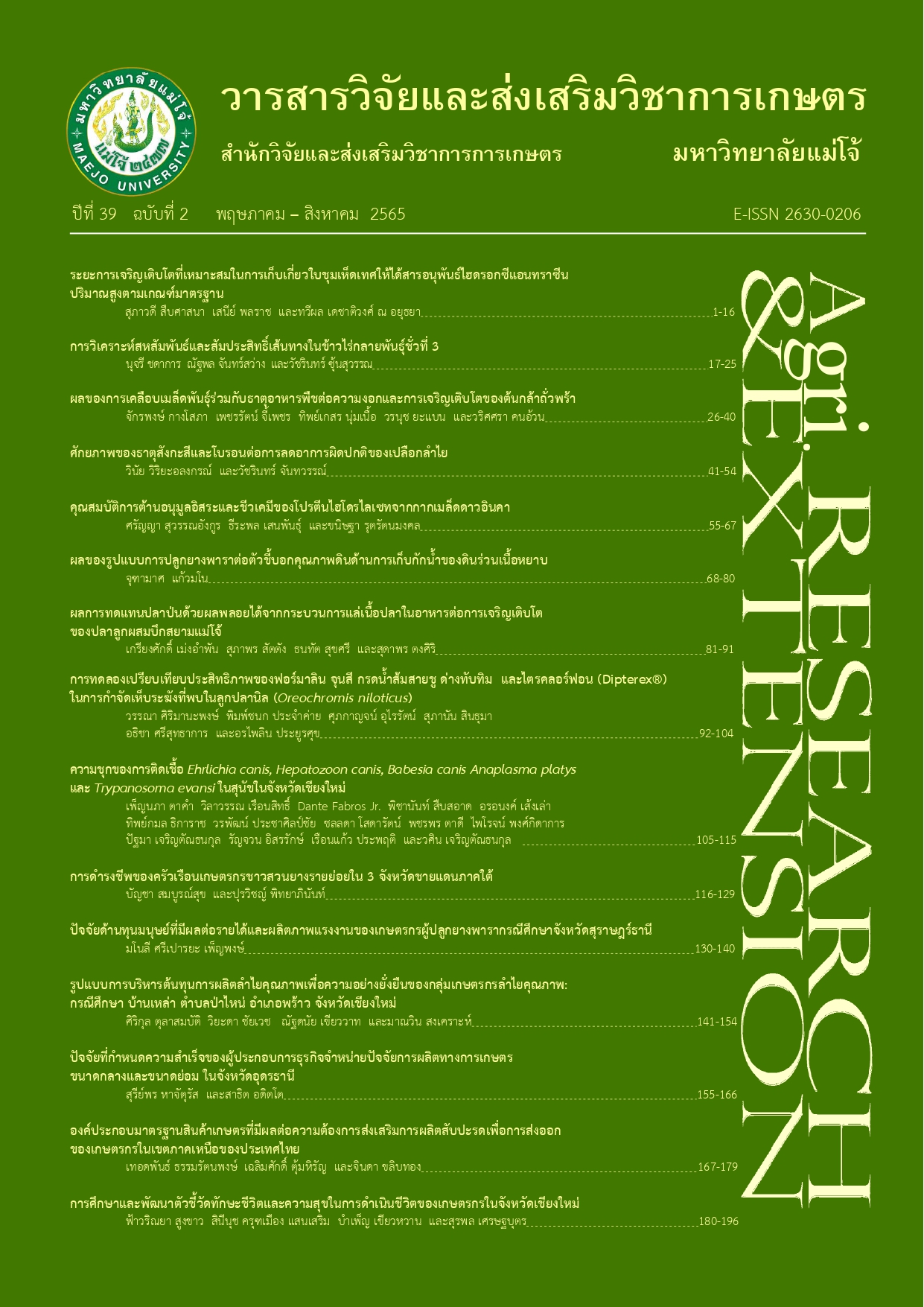ผลของรูปแบบการปลูกยางพาราต่อตัวชี้บอกคุณภาพดินด้านการเก็บกักน้ำของดินร่วนเนื้อหยาบ
คำสำคัญ:
ตัวชี้บอกคุณภาพดิน, น้ำในดิน, รูปแบบการปลูก, ยางพาราบทคัดย่อ
คุณภาพดินในเขตรากพืชมีอิทธิพลมากต่อการให้ผลผลิตของพืชและสุขภาพระบบนิเวศ และมีการเปลี่ยนแปลงได้ง่ายตามรูปแบบการใช้และจัดการดิน จึงมีวัตถุประสงค์เพื่อศึกษาผลของรูปแบบการปลูกยางพาราต่อสมบัติดินทางกายภาพและเคมี ที่ใช้เป็นตัวชี้บอกคุณภาพดินด้านการกักเก็บน้ำในดินร่วนที่มีเนื้อหยาบ โดยเก็บดินที่ปลูกยางพาราต่างกัน 3 รูปแบบ ซึ่งอยู่ในบริเวณใกล้เคียงกันในพื้นที่เดียวกันประกอบด้วย การปลูกแบบผสมผสาน แบบมีพืชร่วม และแบบเชิงเดี่ยว และวิเคราะห์สมบัติดินทางกายภาพและเคมี ผลการศึกษาพบว่า การปลูกยางพาราแบบเชิงเดี่ยวทำให้ชั้นดินล่างมีความหนาแน่นรวมเพิ่มขึ้นอยู่ในระดับสูง (1.64 กรัม/ลบ.ซม.) แตกต่างกันอย่างมีนัยสำคัญทางสถิติ ส่วนการปลูกยางพาราแบบผสมผสานและแบบมีพืชร่วม ช่วยส่งเสริมความพรุนรวมทั้งในชั้นดินบน (0-25 ซม.) และดินล่าง (25-50 ซม.) ซึ่งช่วยรักษาความหนาแน่นรวมของดิน (1.35-1.60 กรัม/ลบ.ซม.) ให้อยู่ในช่วงที่เหมาะสมต่อการเจริญเติบโตของพืช ส่งเสริมความสามารถในการเก็บกักน้ำ ดินปลูกยางพาราทุกรูปแบบมีปริมาณอินทรียวัตถุ (6.79-15.79 กรัม/กก.) ความพรุนรวม (ร้อยละ 37-48) ความจุน้ำใช้ประโยชน์ได้ (80-90 มม./เมตร) และความจุการอุ้มน้ำภายในความลึก 50 ซม. (184-206 มม.) ไม่แตกต่างกันอย่างมีนัยสำคัญทางสถิติ ดังนั้นการจัดการดินปลูกยางพาราเชิงอนุรักษ์ในลักษณะแบบผสมผสาน และแบบมีพืชร่วม ช่วยส่งเสริมคุณภาพดินด้านการเก็บน้ำ โดยปริมาณอินทรียวัตถุและความหนาแน่นรวมดินเป็นปัจจัยสำคัญในการควบคุมคุณภาพดินด้านการเก็บกักน้ำของดินร่วนเนื้อหยาบที่ใช้ปลูกยางพารา
เอกสารอ้างอิง
Alliaume, F., W.A.H. Rossing, M. García, K.E. Giller and S. Dogliotti. 2013. Changes in soil quality and plant available water capacity following systems re-design on commercial vegetable farms. European Journal of Agronomy 46: 10-19.
Blanco, H. and R. Lal. 2008. Principles of Soil Conservation and Management. Kansas: Springer+Business Media. 617 p.
Bodner, G., D. Leitner and H.P. Kaul. 2014. Coarse and fine root plants affect pore size distributions differently. Plant Soil 380: 133-151.
Boonyawat, S. and C. Kongsom. 1989. Pore size distribution of soils in the tropical rain forest and the rubber plantation in Southern Thailand. Thai Journal of Forestry 8: 42-59. [in Thai]
Gregorich, E.G. and M.R. Carter. 1997. Soil Quality for Crop Production and Ecosystem Health. Amsterdam: Elsevier Science B.V. 448 p.
Hazelton, P.A. and B.W. Murphy. 2007. Interpreting Soil Test Results: What do all the number mean? Australia: CSIRO PUBLISHING. 152 p.
Hudson, B.D. 1994. Soil organic matter and available water capacity. Journal of Soil and Water Conservation 49: 189-194.
Kiriratnikom, A. and S. Photisuntorn. 2011. Soil and nutrient loss by soil erosion in para rubber planting area, Thamohd district, Phatthalung province. Journal of Forest Management 5: 33-42. [in Thai]
Klute, A. (Editor). 1986. Methods of Soil Analysis Part 1: Physical and Mineralogical Methods. Wisconsin: American Society of Agronomy, Inc. 1188 p.
Kungpisdan, N. 2009. Sustainable Rubber Plantation Management: Soil, Water and Nutrient. Bangkok: Rubber Research Institute, Department of Agriculture. 210 p. [in Thai]
Lal, R. and M.K. Shukla. 2004. Principles of Soil Physics. New York: Marcel Dekker, Inc. 716 p.
Nandris, D., R. Moreau, F. Pellegrin, H. Chrestin, J. Abina, and P. Angui. 2004. Rubber tree (Hevea brasiliensis) bark necrosis syndrome: II. First comprehensive report on causal stresses. Plant Disease 88(9): 1047. [Online]. Available https://www. apsjournals.apsnet.org/doi/10.1094/PDIS. 2004.88.9.1047A (20 January 2021).
Njar, G.N., A.I. Iwara, U.E. Ekukinam, T.N. Deekor and S.O. Amiolemen. 2011. Organic carbon and total nitrogen status of soils under rubber plantation of various ages, south-southern Nigeria. Journal of Environmental Science and Resource Management 3: 1-13.
Onthong, J. and C. Poonpakdee. 2004. Manual of Soil and Plant analysis. Songkhla: Earth Science Department, Faculty of Natural Resources, Prince of Songkla University. 175 p. [in Thai]
Rubber Research Institute. 2010. Kho Mun Wi Cha Kan Yang Pha Ra. Bangkok: Department of Agriculture, Ministry of Agriculture and Cooperatives. 124 p. [in Thai]
Topp, G.C., W.D. Reynolds, F.J. Cook, J.M. Kirby and M.R. Carter. 1997. Physical Attributes of Soil Quality. pp. 21-58. In Gregorich, E.G. and M.R. Carter (eds.). Soil Quality for Crop Production and Ecosystem Health. Netherlands: Elsevier Science B.V.
Yogaratnam, N. 2000. Rubber land suitability evaluation. Bulletin of the Rubber Research Institute of Sri Lanka 41: 33-38.
Zhang, H., G.L. Zhang, Y.G. Zhao, W.J. Zhao and Z.P. Oi. 2007. Chemical degradation of a Ferralsol (Oxisol) under intensive rubber (Hevea brasiliensis) farming in tropical China. Soil and Tillage Research 93: 109-116.
ดาวน์โหลด
เผยแพร่แล้ว
รูปแบบการอ้างอิง
ฉบับ
ประเภทบทความ
สัญญาอนุญาต
ลิขสิทธิ์ (c) 2022 วารสารวิจัยและส่งเสริมวิชาการเกษตร

อนุญาตภายใต้เงื่อนไข Creative Commons Attribution-NonCommercial-NoDerivatives 4.0 International License.
บทความนี้ได้รับการเผยแพร่ภายใต้สัญญาอนุญาต Creative Commons Attribution-NonCommercial-NoDerivatives 4.0 International (CC BY-NC-ND 4.0) ซึ่งอนุญาตให้ผู้อื่นสามารถแชร์บทความได้โดยให้เครดิตผู้เขียนและห้ามนำไปใช้เพื่อการค้าหรือดัดแปลง หากต้องการใช้งานซ้ำในลักษณะอื่น ๆ หรือการเผยแพร่ซ้ำ จำเป็นต้องได้รับอนุญาตจากวารสาร





